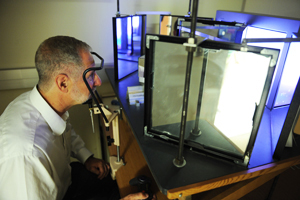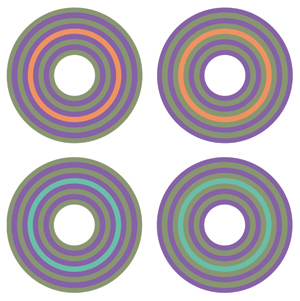Vision quest
Psychologist Steven Shevell breaks down how the brain processes what the eye sees.
By Burke Frank, ’11
Photography by Dan Dry

Shevell designed this haploscope to present different images to each eye.
Why is the sky blue? Middle-school science students learn that sunlight refracting in the atmosphere scatters high-frequency electromagnetic radiation—blue light. But according to neuroscientist Steve Shevell, a Chicago professor of psychology, ophthalmology, and visual science, it’s all in your head: “Color is a biological, perceptual experience—some might even say a mental experience, because it involves the brain. It’s not a direct consequence of physics.”
After earning a bachelor’s in psychology and a master’s in engineering, Shevell says, his curiosity about the brain made a “fairly straight line” to mathematical psychology, his PhD concentration at the University of Michigan. “My first interest in psychology was in human memory, particularly mathematical models for how we learn,” he says. He focused on vision because of the vast opportunity he saw to mathematically model how we see: “Mathematical theories of vision have advanced beyond anything I then imagined.”
Shevell’s research explores how the brain receives, encodes, and interprets the information about light that comprises our visual experience, and many of his findings undermine an intuitive sense of how we see the world. One misconception that he and others have rebutted: that people see and process objects whole. What we perceive as properties essential to whole objects—a stop sign’s red octagon, for instance—are actually processed by separate pathways of the brain. One pathway might recognize the octagon, another the color red. Yet another part of the brain brings them together.
In an ongoing experiment planned for presentation next May, doctoral student Para Kang, AM’08, seeks to demonstrate how separate these processes really are. On a computer screen, participants see parallel spinning lines that simultaneously change color as they rotate. Subjects are asked to identify the orientation and color of the lines at specified times—they might report 30-degree red lines or horizontal yellow ones.
What Shevell and Kang find is the orientation and color combinations that subjects report were never on the screen. Although a participant might observe horizontal yellow lines, the lines were in fact green when they were horizontal. The lines on the screen were only yellow at 30 degrees, a fraction of a second different in time than when the lines were horizontal. So while both yellow lines and horizontal lines were shown, they were never both at once. Shevell explains that the part of the neural pathway that processes line orientation works faster than the part that perceives color—around two-tenths of a second faster. By the time the brain processes the yellow color, the orientation of the lines can shift. But because the brain’s job is to associate the two attributes simultaneously, the different processing speeds can cause a color and orientation to be associated even though they were presented at different times.

The two top circles contain the same color orange rings; the two bottom circles, the same color blue.
Shevell gives the example of a spinning beach ball with red and white stripes. As the ball both spins and moves toward you, your brain receives light information about color, orientation, and velocity all at once, but each is processed at a different pace. “What you experience is not something that was ever actually out in the natural world in the beach ball,” Shevell says. “That’s because the color arrives at one speed—it’s rather late to the party—and the orientation and the velocity, in particular, arrive much faster.”
In another experiment, Shevell pits one eye against the other to demonstrate how separate visual pathways attempt to reconcile conflicting visions of the external world. The technique, he says, shows that the wavelength of light that hits the eye doesn’t always match up with the color a person experiences.
Shevell directs two lights at the participants, one at each eye, both flashing from red to green three times per second. When the lights are synchronized, so both are green or red at the same time, the subject perceives a color that corresponds to the wavelengths of light hitting his eyes—a blinking from green to red three times a second. But when the blinking in the two eyes is staggered, so one eye sees red while the other sees green, a phenomenon called “color rivalry” forces the brain to reconcile conflicting stimuli not ordinarily present in nature.
As the colors alternate in each eye, the brain makes the reasonable assumption that one color or the other is the true hue. As the brain selects, say, red over green, the neural response to the chosen color weakens after a second or two—much as a muscle weakens while holding a weight. As the response weakens, the neural response to the other color begins to outweigh the first, causing the subject to see a change in color. But because this neural weariness takes a few seconds to accumulate, participants mistakenly perceive the color as only changing once every three or four seconds. “When green signals fatigue, then they stop responding and the red takes over again,” says Shevell. “It’s like a tug-of-war.”

In this image from Shevell's lab, identical horizontal bars appear different in brightness.
The wavelength of light that hits the eye and the color the brain perceives are two separate phenomena, Shevell says. “Normally, they’re correlated. That’s why a rainbow has so many colors, because refraction through the atmosphere spreads out the wavelengths,” Shevell says. In this study, “we change the physical wavelengths arriving at the eye three times a second, but a person looking at these lights perceives a change in color every three or four seconds—ten times longer at least.”
Some rare neurological disorders exemplify the brain’s separation of object properties, rendering patients unable to identify whole objects—a process called object representation. “So if I say to you, ‘Touch the square,’ you can do it. ‘Point out the green thing,’ you can do it. But if I say, ‘Point out the green square,’ you can’t,” Shevell says.
The phenomena involved in these experiments, which might seem like mere novelties of optical illusion, for Shevell serve a larger purpose. “What you see isn’t simply a function of the external physical environment,” says Shevell. “Most people think that the appreciation of colors is in the domain of physics—physical energy. But actually, that’s completely wrong.” Analyzing the way the brain mistakes the physical world helps reveal the neural processes at work.Return to top
WRITE THE EDITOR
E-MAIL THIS ARTICLE
SHARE THIS ARTICLE
ALSO IN INVESTIGATIONS
RELATED READING
- “More Than Meets the Eye” (University of Chicago Magazine, June/04)
